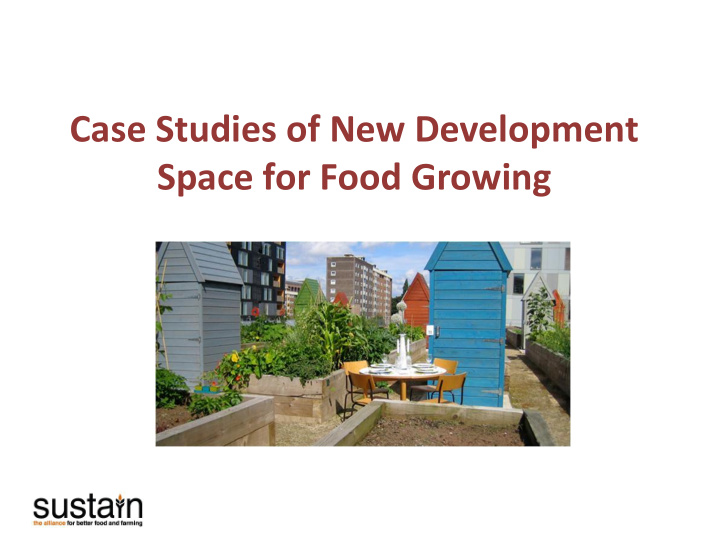



Case Studies of New Development Space for Food Growing
Brighton Planning Context Brighton and Hove Planning Advice Note 06, Food Growing and Development, 2011: • “ Recognise, safeguard, and encourage the role of allotments & garden plots within developments” • Goal: allotment provision of at least 0.23 ha per 1000 residents, maximum 15 minutes walk • Benefits: “ improving the physical and mental health of residents, increasing bio-diversity in cities, reducing carbon emissions associated with long distance food distribution, and greening the urban landscape”
One Brighton • 172 apartment mixed-use development Completed 2010 • set out to be one of the greenest and most sustainable urban communities in Europe • Rooftop mini-allotments & balconies with integrated planters suitable for growing food , ‘ edible landscaping ’
Leeds Sustainable Food City
Leeds Planning Context • make it easier for people to • Core Strategy 2014 lead healthy lifestyles, with better access to fresh food • Aire Valley Area Action shopping, the ability to grow their own food locally, and Plan 2016/7 participate in recreational activities.
Saxton Gardens Before After
Site Plan
Grow Your Own
Newham Planning Context Newham Local Plan – Detailed Sites and Policies Development Plan Document 2016 • Policy SC5 – Maximising Sustainable Design 3. Development should take advantage of linked opportunities in sustainable design and minimise conflict between different strands, notably through: d. the opportunity to integrate food growing , including consideration as a temporary use.
Rathbone Market Canning Town • Area formerly 1960s residential blocks, shops & a failing street market • Development of contemporary apartments now boasts communal gardens and allotments . • Mixed-use development on 5.5 acres with 652 new homes.
Waltham Forest Planning Context Waltham Forest Local Plan - Core Strategy, 2012 • Policy CS5 – Enhancing Green Infrastructure and Biodiversity E “ensuring the adequate provision and efficient use of allotments and other spaces on which to grow food and plants” • 8.20 – “Allotments, community gardens, and urban farms are a useful resource for delivering a range of benefits including providing a healthy and sustainable food resource and fostering opportunities for gentle exercise.” Development Management Policies , 2013 • Policy DM12 “The Council will expect development proposals to contribute to the supply, quality and accessibility of private and communal spaces on which to grow food and flowers”
Walthamstow Stadium • East London, borough of Waltham Forest • Demolition of greyhound racing track besides historic sign • 294 new homes of mixed form and tenure • Community facilities including nursery, café, sports centre, and new pocket allotments
Lessons Learned • Planning policy is a statement of council priorities to guide new development; don’t assume individual policies will be applied in all cases. They are not regulatory mechanisms to be “implemented”. – To create new food growing spaces, use planning policies to show support for your work, combining with other strategies • Not all food growing spaces need planning permission • Some planners, instead of recommending food growing space in new developments, recommend flexible green space that can become allotments, play area, outdoor seating etc, according to residents’ wishes • Developers are trending towards “place making” and “community infrastructure” in new developments – food growing space can help them meet that goal • Policy is the start of the journey, engagement, facilitation and ongoing management are key.
Webinar Key Messages • Sustainable Food Cities Think: what do you want your place to look like? • Developers Improve social & environmental attractiveness of development • Councils Planning for a sustainable food system meets many strategic objectives
Time for Questions & Discussions Post your questions in the chat box Do you have any good examples of new developments to share? What does a sustainable food city will look like? For help with local plan making see our planning pages at https://www.sustainweb.org/planning/ Sign up for our newsletter Email gillian@sustainweb.org
Recommend
More recommend